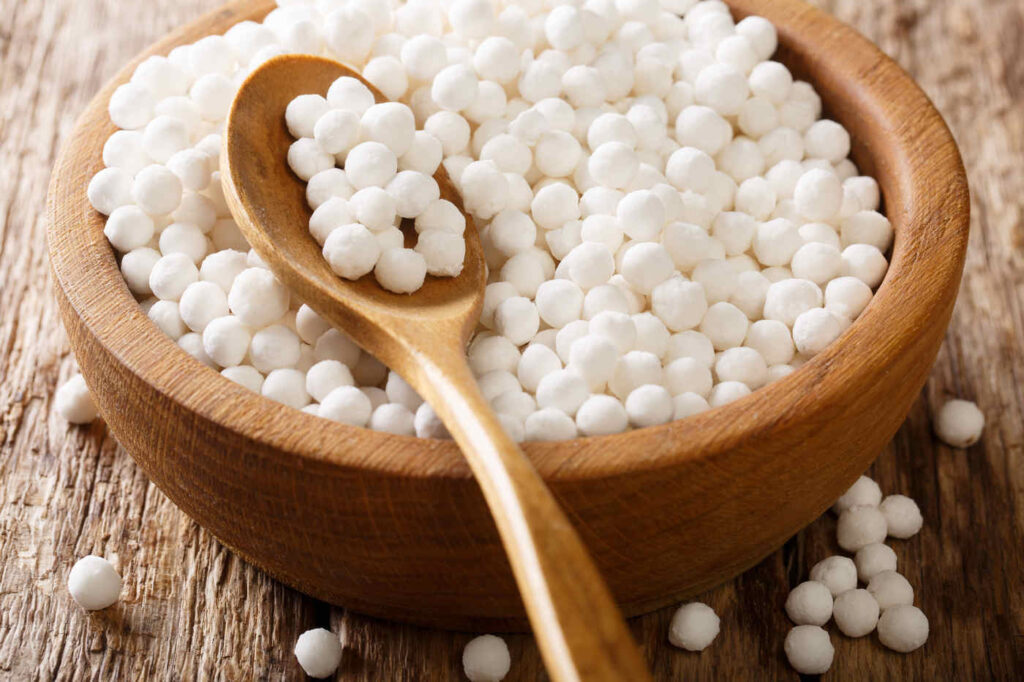Tapioca, a gluten-free starch derived from the cassava root, has become a popular ingredient in kitchens worldwide. Known for its neutral flavor and unique texture, tapioca is a staple in puddings, bubble tea, and gluten-free baking. But beyond its culinary uses, tapioca offers a range of health benefits and nutritional properties.
In this blog post, we’ll dive into the world of tapioca, exploring its benefits, properties, and potential contraindications.
What is Tapioca?
Tapioca is a starch extracted from the cassava plant (Manihot esculenta), native to South America. The cassava root is processed to remove toxins, then dried and ground into flour, pearls, or flakes. Tapioca is naturally gluten-free, making it a popular choice for those with celiac disease or gluten intolerance. It’s also a common thickening agent in soups, sauces, and desserts.
Nutritional Properties of Tapioca
Tapioca is primarily a source of carbohydrates, making it a quick source of energy. While it’s not particularly rich in vitamins or minerals, it does offer some nutritional value:
- Calories: Tapioca is calorie-dense, providing energy for active individuals.
- Carbohydrates: It’s almost entirely composed of carbs, making it easy to digest.
- Fiber: Small amounts of resistant starch in tapioca can support gut health.
- Iron: Some tapioca products are fortified with iron, which is essential for blood health.
- Calcium: Certain forms of tapioca, like pearl tapioca, contain small amounts of calcium.
Tapioca is low in fat, protein, and sodium, making it a simple, clean source of energy.
Health Benefits of Tapioca
- Gluten-Free and Easy to Digest
Tapioca is naturally gluten-free, making it a safe option for people with celiac disease or gluten sensitivity. Its simple carbohydrate structure also makes it easy to digest, which is beneficial for those with digestive issues. - Provides Quick Energy
The high carbohydrate content in tapioca makes it an excellent source of quick energy, ideal for athletes or anyone needing a boost. - Supports Gut Health
Tapioca contains resistant starch, which acts as a prebiotic and feeds beneficial gut bacteria. This can improve digestion and promote a healthy gut microbiome. - Allergen-Friendly
Tapioca is free from common allergens like gluten, nuts, and soy, making it a versatile ingredient for people with food allergies. - Helps with Weight Gain
For individuals looking to gain weight in a healthy way, tapioca’s calorie-dense nature can be a useful addition to their diet. - Soothes the Stomach
Tapioca is often recommended for people recovering from illness or digestive upset because it’s gentle on the stomach and easy to tolerate. - Versatile in Cooking
Tapioca’s neutral flavor and thickening properties make it a versatile ingredient in both sweet and savory dishes, from puddings to soups.
Contraindications and Precautions
While tapioca is generally safe for most people, there are a few considerations to keep in mind:
- High in Calories and Carbs
Tapioca is calorie-dense and high in carbohydrates, which may not be suitable for individuals managing diabetes or those on low-carb diets. - Low in Protein and Nutrients
Tapioca lacks significant amounts of protein, vitamins, and minerals. Relying on it as a primary food source can lead to nutritional deficiencies. - Potential for Cyanide Toxicity
Cassava, the root from which tapioca is derived, contains naturally occurring cyanogenic glycosides, which can release cyanide if not properly processed. Commercially produced tapioca is safe, but improperly processed cassava can be toxic. - Allergic Reactions
While rare, some individuals may experience allergic reactions to tapioca. Symptoms can include itching, swelling, or difficulty breathing. - Digestive Issues
Consuming large amounts of tapioca can cause bloating or gas due to its resistant starch content. Moderation is key. - Not Suitable for Low-FODMAP Diets
Tapioca is high in FODMAPs (fermentable oligosaccharides, disaccharides, monosaccharides, and polyols), which can trigger symptoms in people with irritable bowel syndrome (IBS).
How to Use Tapioca in Your Diet
Tapioca is incredibly versatile and can be used in a variety of ways:
- Tapioca Pearls: Use them to make bubble tea, puddings, or desserts.
- Tapioca Flour: Use it as a thickening agent in soups, sauces, and gravies, or as a gluten-free flour alternative in baking.
- Tapioca Starch: Ideal for making chewy baked goods or as a binder in recipes.
- Tapioca Flakes: Add them to porridge or use them as a topping for yogurt and smoothie bowls.

Tapioca is a versatile, gluten-free starch that offers a range of culinary and health benefits. From providing quick energy to supporting gut health, it’s a valuable addition to many diets. However, it’s important to consume tapioca in moderation and be mindful of its potential drawbacks, such as its high calorie and carbohydrate content.
Whether you’re enjoying a creamy tapioca pudding or using tapioca flour to thicken a soup, this humble starch can add both texture and nutrition to your meals. Just remember to balance it with other nutrient-rich foods to ensure a well-rounded diet.
Disclaimer: This blog post is for informational purposes only and is not a substitute for professional medical advice. Always consult a healthcare provider before making significant changes to your diet or health routine.

